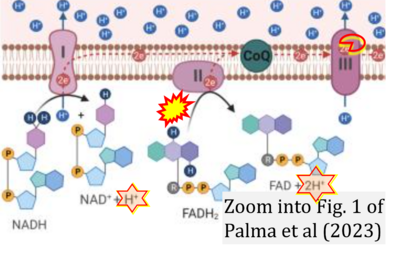Palma 2023 Oncogene
| Palma FR, Gantner BN, Sakiyama MJ, Kayzuka C, Shukla S, Lacchini R, Cunniff B, Bonini MG (2023) ROS production by mitochondria: function or dysfunction?. Oncogene https://doi.org/10.1038/s41388-023-02907-z |
Palma FR, Gantner BN, Sakiyama MJ, Kayzuka C, Shukla S, Lacchini R, Cunniff B, Bonini MG (2023) Oncogene
Abstract: In eukaryotic cells, ATP generation is generally viewed as the primary function of mitochondria under normoxic conditions. Reactive oxygen species (ROS), in contrast, are regarded as the by-products of respiration, and are widely associated with dysfunction and disease. Important signaling functions have been demonstrated for mitochondrial ROS in recent years. Still, their chemical reactivity and capacity to elicit oxidative damage have reinforced the idea that ROS are the products of dysfunctional mitochondria that accumulate during disease. Several studies support a different model, however, by showing that: (1) limited oxygen availability results in mitochondria prioritizing ROS production over ATP, (2) ROS is an essential adaptive mitochondrial signal triggered by various important stressors, and (3) while mitochondria-independent ATP production can be easily engaged by most cells, there is no known replacement for ROS-driven redox signaling. Based on these observations and other evidence reviewed here, we highlight the role of ROS production as a major mitochondrial function involved in cellular adaptation and stress resistance. As such, we propose a rekindled view of ROS production as a primary mitochondrial function as essential to life as ATP production itself.
• Bioblast editor: Gnaiger E
Correction: FADH2 and Complex II
- FADH2 is shown as the substrate feeding electrons into Complex II (CII). This is wrong and requires correction - for details see Gnaiger (2024).
- Gnaiger E (2024) Complex II ambiguities ― FADH2 in the electron transfer system. J Biol Chem 300:105470. https://doi.org/10.1016/j.jbc.2023.105470 - »Bioblast link«
Hydrogen ion ambiguities in the electron transfer system
Communicated by Gnaiger E (2023-10-08) last update 2023-11-10
- Electron (e-) transfer linked to hydrogen ion (hydron; H+) transfer is a fundamental concept in the field of bioenergetics, critical for understanding redox-coupled energy transformations.
- However, the current literature contains inconsistencies regarding H+ formation on the negative side of bioenergetic membranes, such as the matrix side of the mitochondrial inner membrane, when NADH is oxidized during oxidative phosphorylation (OXPHOS). Ambiguities arise when examining the oxidation of NADH by respiratory Complex I or succinate by Complex II.
- Oxidation of NADH or succinate involves a two-electron transfer of 2{H++e-} to FMN or FAD, respectively. Figures indicating a single electron e- transferred from NADH or succinate lack accuracy.
- The oxidized NAD+ is distinguished from NAD indicating nicotinamide adenine dinucleotide independent of oxidation state.
- NADH + H+ → NAD+ +2{H++e-} is the oxidation half-reaction in this H+-linked electron transfer represented as 2{H++e-} (Gnaiger 2023). Putative H+ formation shown as NADH → NAD+ + H+ conflicts with chemiosmotic coupling stoichiometries between H+ translocation across the coupling membrane and electron transfer to oxygen. Ensuring clarity in this complex field is imperative to tackle the apparent ambiguity crisis and prevent confusion, particularly in light of the increasing number of interdisciplinary publications on bioenergetics concerning diagnostic and clinical applications of OXPHOS analysis.




